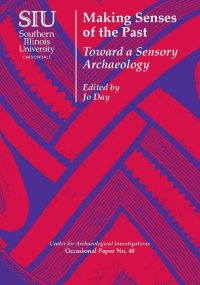
Ebook: Making senses of the past : toward a sensory archaeology
Author: Jo Day
- Tags: Archaeology -- Methodology -- Congresses, Senses and sensation -- Congresses, Archaeology -- Social aspects -- Congresses, Archaeology -- Psychological aspects -- Congresses, Material culture -- Social aspects -- Congresses, Material culture -- Psychological aspects -- Congresses, Archäologie, Sinne
- Series: Center for Archaeological Investigations Occasional paper no. 40
- Year: 2013
- Publisher: Occasional Papers
- Language: English
- pdf
Since the nineteenth century, museums have kept their artifacts in glass cases to better preserve them, and drawings and photographs have become standard ways of presenting the past. These practices have led to an archaeology dominated by visual description, even though human interaction with the surrounding world involves the whole body and all of its senses. In the past few years, sensory archaeology has become more prominent, and Making Senses of the Past is one of the first collected volumes on this subject. This book presents cutting-edge research on new theoretical issues. The essays presented here take readers on a multisensory journey around the world and across time.
In ancient Peru, a site provides sensory surprises as voices resound beneath the ground and hidden carvings slowly reveal their secrets. In Canada and New Zealand, the flicker of reflected light from a lake dances on the faces of painted rocks and may have influenced when and why the pigment was applied. In Mesopotamia, vessels for foodstuffs build a picture of a past cuisine that encompasses taste and social activity in the building of communities. While perfume and flowers are examined in various cultures, in the chamber tombs of ancient Roman Palestine, we are reminded that not all smells are pleasant. Making Senses of the Past explores alternative ways to perceive past societies and offers a new way of wiring archaeology that incorporates the senses.
In ancient Peru, a site provides sensory surprises as voices resound beneath the ground and hidden carvings slowly reveal their secrets. In Canada and New Zealand, the flicker of reflected light from a lake dances on the faces of painted rocks and may have influenced when and why the pigment was applied. In Mesopotamia, vessels for foodstuffs build a picture of a past cuisine that encompasses taste and social activity in the building of communities. While perfume and flowers are examined in various cultures, in the chamber tombs of ancient Roman Palestine, we are reminded that not all smells are pleasant. Making Senses of the Past explores alternative ways to perceive past societies and offers a new way of wiring archaeology that incorporates the senses.
Download the book Making senses of the past : toward a sensory archaeology for free or read online
Continue reading on any device:

Last viewed books
Related books
{related-news}
Comments (0)